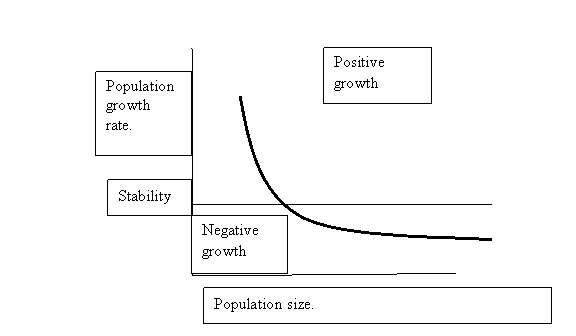The arms of nature:
Look at is this way.
If one were to say, “Don’t let nature get her hands on you,” it would only be common prudence. We all know a lot about what nature can do that is bad.
But here is the Sibly curve:

Drawn from Sibly’s results comparing the growth rate and population sizes of over a thousand wild populations. Growth rate is on the vertical axis; population size is on the horizontal. After Richard Sibly et al. On the Regulation of Populations of Mammals, Birds, Fish and Insects SCIENCE vol. 309 July 22, 2005 page 609.
It shows how fertility changes with population size and hence with average kinship. There are two arms to the curve: small populations grow rapidly; Large populations decline slowly. About where the arms join there is a region of stability. Obviously unlimited growth must lead to catastrophe and unlimited decline will as well. But as long as a population remains on the curve nature will draw it into her arms toward stability. One might say that is her heart. She draws you close to it.
But at the ends of the arms are the hands. The one hand catches the very small population, adds inbreeding depression to the problems that caused the decline to that point, and flings the population into the garbage. The other hand catches a population that is large and stops reproduction altogether, as was demonstrated by Calhoun. (John Calhoun Death Squared: The Explosive Growth and Demise of a Mouse Population Proceedings of the Royal Society of Medicine vol. 66, January 1973 page 80.) Again the population goes into the garbage.
There are probably populations of humans today that are being subjected to inbreeding depression. I’ve not seen hard data on that. But in the developed world almost all the population is far out on the low kinship and low fertility arm. There are two pressing questions.
- Do we still have time to change our pattern before the inevitable final fall in fertility (This accumulates over generations of course.) and extinction?
- Will we even try?
The survival of civilization depends on both answers being yes. They may both be no.
There have been 113 visitors over the past month.
Home page.
